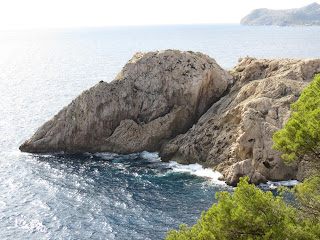And so, with a last morning stroll along Pinewalk on the foreshore of Port Pollença, my vacation in the Balearic Islands was at an end. All I had left to do was drive the rental car to the airport (and hope for no breakdown or traffic jams) and take off.
What would I have done different? Not very much actually, the plan and its execution were very satisfactory. Perhaps I could have reduced my stay in Eivissa by one day and stayed one more day in Formentera or Mallorca instead. In fact with hindsight I would gladly skip Eivissa if it were not for amazing Formentera. I now understand why there are few guide books about Eivissa.
Mallorca and Eivissa are what I call wide airports, that have to handle a large flow of passengers very quickly but little variation in needs, as opposed to deep airports like Sydney, where they try to make passengers linger in labyrinthine passages to spend more. Mallorca has so many departures in peak that they only tell you the zone (A-D) you have to go to and about an hour before departure, they assign one of about a dozen gates.
It seemed like the whole of Germany was in Mallorca over the weekend, leaving some Turks behind to keep the country running. But I think it looked that way because Air Berlin has made such a determined push into Mallorca that they use up an entire zone.
I dislike airports, especially crowded ones. Adults are usually stressed or even panicking and don't watch where they are going so you have to dodge distracted people. Worse still if they are trying to work the mobile, smartphone or whatever at the same time. Kids gleefully take advantage of the confusion to run amok.
Please I thought, as we boarded, let me have a passenger in the next seat who is slim, pretty and sexy. In that order, because on the Eivissa to Mallorca leg there was a fat lug in the next seat and his elbow poked my kidney. In the event I ended up next to a young man with his wife so I can't complain. Two stopovers and 32 hours later, which you won't be interested to read about, I was home.
What would I have done different? Not very much actually, the plan and its execution were very satisfactory. Perhaps I could have reduced my stay in Eivissa by one day and stayed one more day in Formentera or Mallorca instead. In fact with hindsight I would gladly skip Eivissa if it were not for amazing Formentera. I now understand why there are few guide books about Eivissa.
Mallorca and Eivissa are what I call wide airports, that have to handle a large flow of passengers very quickly but little variation in needs, as opposed to deep airports like Sydney, where they try to make passengers linger in labyrinthine passages to spend more. Mallorca has so many departures in peak that they only tell you the zone (A-D) you have to go to and about an hour before departure, they assign one of about a dozen gates.
It seemed like the whole of Germany was in Mallorca over the weekend, leaving some Turks behind to keep the country running. But I think it looked that way because Air Berlin has made such a determined push into Mallorca that they use up an entire zone.
I dislike airports, especially crowded ones. Adults are usually stressed or even panicking and don't watch where they are going so you have to dodge distracted people. Worse still if they are trying to work the mobile, smartphone or whatever at the same time. Kids gleefully take advantage of the confusion to run amok.
Please I thought, as we boarded, let me have a passenger in the next seat who is slim, pretty and sexy. In that order, because on the Eivissa to Mallorca leg there was a fat lug in the next seat and his elbow poked my kidney. In the event I ended up next to a young man with his wife so I can't complain. Two stopovers and 32 hours later, which you won't be interested to read about, I was home.

















































